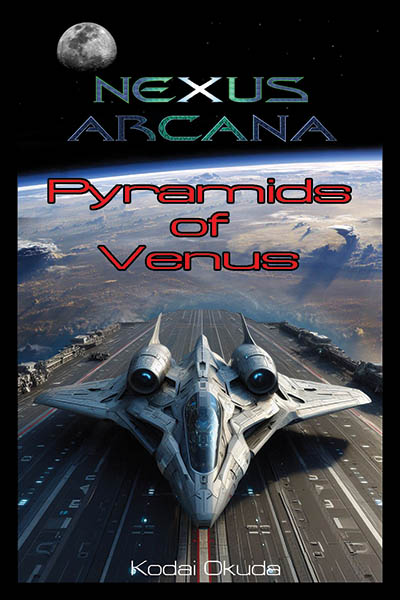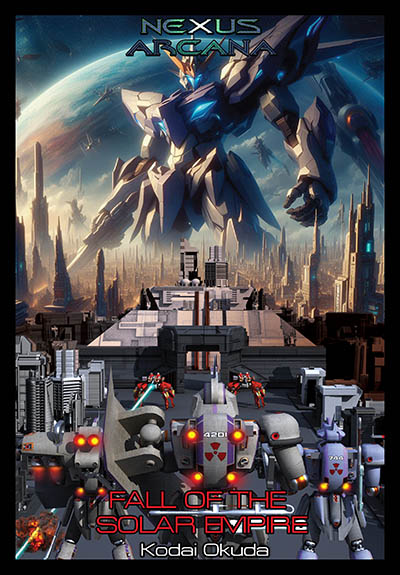Jhararo's All the Galaxy's Warships Vol. 5: Spacecraft Design Concepts (part 2)
by , 05-28-2012 at 03:04 AM (232944 Views)
Welcome to the May issue of Jhararo's All the Galaxy's Warships, the digital database dedicated to the study of mechanical devices, weapons, vehicles, and other machines of the known galactic nations.
This Month's Issue: PART 2 Earth Federal Republic (EFR) spacecraft design concepts of the 1st Interplanetary War era.
* * *
INTRODUCTION TO PART 2
The spacecraft of the Earth Federal Republic were initially designed in 2063 and were in prototype form in 2065 AD. Full production of these craft was not begun until 2068 after it became clear that the UN had developed an FTL drive system.
All three of the initial classes of warships built by the Earth Federal Republic space forces (later renamed SpaceNavy) were based on pre-Great War submarine designs that had been the mainstay of the United States of North America ocean forces and subsequently the Earth Federal Republic as of 2056 AD.
* * *
From Great War Era Wet Navy to Earth Federal Forces SpaceNavy
Because the surface of the Earth had been ravaged by the asteroid impact of 2056 AD, and the air choked with dust and debris, only ocean vessels were capable of traversing large distances on the planet. In order to avoid detection, submarines were considered to be the best means of travel on Earth for the last half of the 2050s and the early 2060s.
With resources in short supply, it was not ergonomically feasible for the fledgling EFR to build their new space-fleet from scratch. They needed hulls to use to construct their initial force of spacecraft.
The Earth Federal Republic took full advantage of the their existing fleet of submersible ocean-craft and used the hulls of the three main submarine type vessels that had been the mainstay to traverse the planet during the 12 years of darkness.
It is important to note that each of these three types of submarines influenced the thinking that went into the design and construction of what would ultimately become the "Space Cruiser" style of spacecraft.
The Cousteau Class becomes the Arctic class
Built during the Asian Pacific conflict of the mid-2040s, the Cousteau class of coastal patrol boat served as the model for the destroyer-escorts that the EFF military planners had in mind in 2063 AD. They needed a craft that would be near 1000 tons hydrogen displacement and capable of using the newly developed Tesla-Schauberger Repulsine gravitational control unit. The cylindrical hull of the old Cousteau class was perfect for this gravitational unit and was the only craft of that size that still retained the classic cylindrical shape since the saucer/manta-ray body style had replaced most of the cigar-shaped types during the 2030s.
At 860 tons, the Cousteau was the perfect match for the new Arctic Class. The old submarine was armed with ten torpedo launch tubes positioned on the hull in areas similar to that of what the Earth Federal Forces space-warship design team had envisioned for the new Arctic class to have. Thus the Arctic class also mounted "torpedo" tubes in a manner very similar to that of the Cousteau class save for the fact that the space-torpedoes used by the Arctic were larger and thus only six tubes were mounted on the new destroyer escort.
While most of the Cousteau class submarine's hull was heavily modified during its conversion to the Arctic class, the Arctic still retained the cylindrical hull of its predecessor. The method for conversion from Cousteau to Arctic consisted of removing the aft third of the submarine and adding the main engine, trio of secondary engine pods, and moving the bridge section rearward. The gravitational control unit was added during this phase and positioned at the vessel's center of gravity, just forward of the hangar bay unit. The original Cousteau class hangar deck was intended for mini-subs and underwater exosuits and not the considerably larger HSF-01 space fighter.
This reconfiguration of the Cousteau into the Arctic class set the precedence for the refit of the Typhon and Yucatan class submarines into spacecraft.
The Typhon Class becomes the Colorado Class
The Typhon class was a 4800 ton attack submarine intended for high speed underwater maneuvers and long-range endurance missions. It's hull was an excellent choice for the space-destroyer type of warship the EFF warship design team was looking for. A similar process of conversion to that of the Cousteau/Arctic refit was used on the Typhon/Colorado class upgrade. The last third of the Typhon was removed from the hull and a new "cosmo-drive" section was added to the vessel that contained the main engine, triple cluster of secondary engine pods, and redesigned hangar section. An additional 1200 tons was added to the Typhon hull during the refit. This included the Tesla-Schauberger Repulsine Gravitational unit, as well as all new environmental control systems, electrical power conduits, and a larger fusion--rather than fission--reactor.
The transition from 4800 ton Typhon to 6000 ton Colorado class wasn't that difficult. Both used forward firing torpedo tubes for missiles that were nearly the same diameter, volume, and size. Thus the hard-points of the Typhon allowed for direct replacement of its old ocean torpedo launchers with the space-torpedo weapon systems. However, the top two torpedo tubes had to be removed due to the addition of the nuclear dampeners and other systems. This reduced the torpedo tubes from Typhon's twelve launchers to only ten on the Colorado. ]
During the refit process of the Typhon class, the decision was made to add rail-cannon turrets for ship-to-ship combat and point-defense. These turrets were mounted in strategic positions: one top forward, one bottom forward, one top aft, and one bottom center. This practice of mounting both top and bottom turret batteries would become a staple of "Space Cruiser" style designs for centuries to come.
The Yucatan Class becomes the Anapolis Class
Unlike the Cousteau or the Typhon class before it, the Yucatan was not the ideal match for the 12,000 ton space cruiser that the EFF designers had hoped for. The aft section, bow section, and lack of a hangar bay made the 9600 ton Yucatan less than desirable. However, with no other hulls in the 8000-12,000 ton class available to them, they had no choice but to make the new Anapolis class design fit into the hull of the existing Yucatan submarines they had. Originally Anapolis was meant to be a 12,000 ton battlecruiser, however, the team was unable to stretch the limits of the Yucatan design to the 12,000 ton mark and so scaled back the original space cruiser design to meet the reality of what they had on hand.
Yucatan did offer the designers a great deal of internal volume to work with after the eighteen ICBM silos were removed from the hull amidships. This internal volume allowed for a comfortable placement of the gravitational unit, fusion reactor, internal utilities, new ventilation systems, and the addition of a hangar bay that the original Yucatan lacked. Even with these difficulties, the EFF design team managed to construct an admirable line of warships from an old Great War era ballistic missile submarine.
The Anapolis paved the way for the "maw gun" weapon system that would become a staple of capital ships in the "Space Cruiser" style of cosmo-warships. Originally this weapon was a heavy laser cannon mounted at the bow of the vessel and was intended to act as a long-range artillery weapon against space-stations and fixed positions like planetoid bases. It also solidified the use of turret mounted batteries, much like the ocean ships before it, with ten rail-cannons mounted in turrets with batteries of two cannons each. The Anapolis class was also compact, with a bridge section very close to the hull in the same manner as the Yucatan class before it.
* * *
The USSN influence on EFR design
When contact was made between the EFR and the USSN in 2068 the whole line of Earth Federal Forces SpaceNavy warships was immediately put into yet another refit. This time only the weapons and engines were in need of upgrade. The USSN had been fighting in space combat with the UNSC for over a decade prior to their meeting the EFR. They had learned through experience that energy weapons and fusion thrusters were superior to the rail-cannon turrets and ion engines being used by the fledgling space forces of the EFF. If the new Earth Federal Space Navy was to be victorious over the United Nations Space Corps and ultimately the Solar Empire, then their fleet of warships would have to be effective enough to overcome the numerical superiority of their enemy. It was for this reason that the all three of the EFSN warship designs were fitted with laser cannon turrets, and the maw gun of the Anapolis class capital ships was replaced with an electromagnetic particle accelerator cannon over the old laser. These improvements by the USSN on the EFSN fleet gave the EFR the edge during the initial years of the 1st Interplanetary War period. The assault shuttles of the UNSC were wholly inadequate to handle the warships of the EFSN and the "Space Cruiser" style proved its worth.
* * *
The UN Space-Battleship Threat
When the EFSN launched its assault on the Solar Empire's asteroid and planetoid bases in 2070, the UNSC was overwhelmed by the size, strength, and firepower of the new "Space Cruiser" style of warships. Solar Empire commanders had nothing with which to counter the new line of EFF vessels in their existing fleet. Calls went out for improved ships as the planetoid bases quickly fell. The UNSC fell back to Mars and Venus before the council finally realized the need for action.
The UNSC had begun development of "Project Ironclad" vessels in 2061, but that project ceased in 2062 AD when the assault shuttle forces proved able enough to fend off the USSN fleet of frigates and corvettes. The need for the "Ironclads" in 2072 caused the UNSC to produce the vessels as quickly as the Solar Empire industrial sector was able to pump them out. None of the 1st or 2nd generation of "Ironclads" proved to be much of a help during the various operations meant to drive back the EFSN. The Anapolis class cruisers, with their heavy forward mounted EMPAC weapons, were able to overcome the cruise missile weaponry of the "Ironclads." Even with their new fleet, the UNSC found itself loosing ground to the ever encroaching Earth SpaceNavy. However, in 2073 a new "Mark-III" or third-generation "Ironclad" warship was introduced that essentially was a Solar Empire version of a "Space Cruiser" style warship. This new vessel was the Kiev space-battleships that nearly changed the course of the entire conflict. Had they been built sooner, and in greater numbers, the war would have almost certainly ended in a stalemate.
The threat of this new space-battleship was so great that the Earth Federal Forces cancelled the 20,000 ton "Argentina class" spacecraft carrier begun in early 2073 to meet EFSN requirements for a craft that could carry larger numbers of HSF-01 spacefighters into combat. With the "Argentina class" put aside the EFF shipwrights got to the task of designing and building a space-battleship that could contend with the Kiev.
It took them five years to complete what would be the culmination of 21st century "Space Cruiser" design theory. The Kurita Class was vastly superior to the Kiev and had weapons with ranges far greater than that of the Solar Empire Mark-III "Ironclad." It's hull was built completely from scratch, but still retained all of the features common to the submarine inspired "Space Cruiser" design. Kurita would spur the development of future "Space Cruiser" types and ultimately the "Space Cruiser" style would be one of only two that would dominate Terran ship designs during much of the 22nd century.
* * *
Conclusion of Part 2
From the three basic submarine based warships came the fourth "true" "Space Cruiser" design in the Kurita class. This evolution from wet-navy to SpaceNavy would continue on through the last half of the 21st century with the warships of the Jovian powers, and others into the future.













 Email Blog Entry
Email Blog Entry

